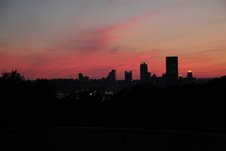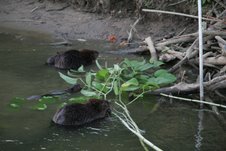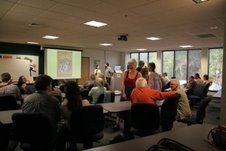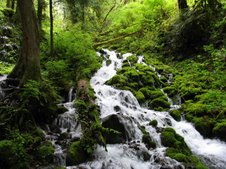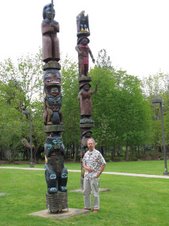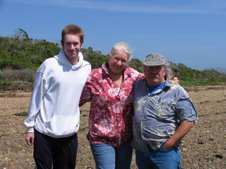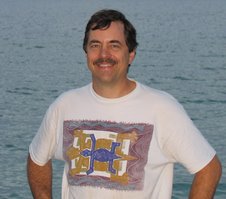Indigo was on the last 400 miles on the U.S. walk and on the last part of the European walk through Greece. She is Water's sister in Pittsburgh. In giving us a tour of their home, we were enthralled by a family of beavers who had made their home along the Allegheny River not far from downtown, a sign that water quality had improved. The air quality had also significantly improved in the past 20-30 years. Pittsburgh is now a leader in green building. During a quiet moment, I had a chance to talk with Indigo about the walks and her life.
“The U.S. walk was a major marker in my life," she said. "It came at a time when my whole life changed in 1984. By the time I made the decision to go on the walk at the end of September, my sister had died and my marriage had ended, so it was perfect timing. It was an empowerment exercise for me. I could walk by my own steam any place. I needed to change, to move, and the fact that I could walk 400 miles was empowering me, putting wind in my sails. Every day that I walked strengthened that. I had been familiarized with community through my visit to Findhorn in 1982, and I had been involved in a sweat lodge circle in Philadelphia, so all those components had me ready for the walk. It was an easy transition—I had a brother on the walk and the walk was pretty together by then. The walkers were all individuals, but they challenged themselves to work together.”
Highlights for Indigo after the walk included traveling to the Soviet Union with a group of artists in 1990 as part of a vision by Raisa Gorbachev and finding a flyer on the street in South Philly that advertised a sacred dancing event before the Great Pyramid in Egypt. “The dance opened a gateway that will remain open until 2011,” she said. “Eleven dances are supposed to occur by then and eight have been done so far. Each one has a certain tone associated with them. Had 130 people from 35 countries participate in the last dance. It’s been my spiritual driver. In the meantime, there were missions like with Water’s spiritual teacher. His mission was to have this peace dance. He saw what I was doing. Did a dance in 1993 and had people native to Ecuador come to do a dance. Purpose—opens a gateway to consciousness either evolutionary or to lay in certain energies. Each gate has a certain tone and energy. What attracts me is its movement with people from all over the world and we come together and work together and it seems like things change. If we love and trust one another, things get better. This group makes this be a focus. It’s not like it’s a religion or a movement, more a way of being.” For more information on the dances, log onto www.nvisible.com.
For her day job, Indigo works as an environmental educator focusing on responsible energy use in homes and businesses. She creates and implements education programs for grades 4 through 12.
To end the East Coast tour, we had a wonderful event at the Quest Bookshop in Charlottesville, Virginia. Our hosts were my adopted sister Ana Aegis (formerly Ann Clothiaux) and her partner Paul. Ana had participated in our 3-week walk in the Pacific Northwest in the late 1990s. It was great to see them and to roam around this progressive and attractive small city in the shadow of the Shenandoahs.
Thursday, July 5, 2007
Wednesday, July 4, 2007
Water Saudauskas: "The hardest step is out the front door"
In Pittsburgh, we stayed with former walkers Water Saudauskas and Indigo Raffel and held three gatherings with diverse and warm people. In the first gathering, one sweat leader named Johnny sang a sweat song for the group. I later spoke with Water about the walk and what he’s been doing since. “Highlights for me on the walk was gaining the ability after about a month to walk 18 miles and knowing that it was doable and easy, enabling me to become a migratory spiritual animal. Walking enabled me to enter the room of earth balancing where prior I was just knocking at the door, so that I could touch without any repercussions a wild rattlesnake. People we met thought we were doing things that they thought were impossible to them, but in talking with them they realized they could do it—it just takes practice. It is step by step, inch by inch. The hardest step is out the front door.”
Early in the morning during our stay, before dawn, Water left his house to visit a nearby park to “walk into the mystery of the forest.” Water added, “I don’t think I would have that gift without the walk. People use the word balance, to walk in balance, usually in books. I know in my guts and in the soles of my feet what that means because of the walk. I know that I can access it when I do walk.”
What are the highlights of Water’s life since the walk? “I held my father when he was dying so I received a vision that I hope I can manifest in my lifetime; sweating and working to humble myself for ten years with a Mexican-American Buddha-like Vietnam Vet named Luciano Perez; working with my emotionally devastated brother for the last 22 years in Pittsburgh. He’s a lot better because of that. Living in a transitional interracial neighborhood where walking and praying is a survival technique, not something that has an exercise value. It’s a way of living here to survive. In 2000, a mentally-ill African American man went on a killing spree, consciously killing three non-African American people and wounding two. To heal the torn interracial neighborhood, the churches two weeks later had a peace walk that drew 500 people to start to heal the wounds from this man on the community.
“On October 25th, 2001, I stood on Broadway looking into the smoldering hole of 911 praying with seven others that healing would go on. Through the walk and the spiritual discipline of Luciano Perez I had a sense of wonder and respect. The walk started me in arriving there, 17 years later.
“I’m almost 59 now. I don’t have a car, so I use my legs and ride buses. Walking helps me keep sane; that’s correlated to the walk. The walking grounds me so that I don’t put out the fear vibrations to the animals.”
Early in the morning during our stay, before dawn, Water left his house to visit a nearby park to “walk into the mystery of the forest.” Water added, “I don’t think I would have that gift without the walk. People use the word balance, to walk in balance, usually in books. I know in my guts and in the soles of my feet what that means because of the walk. I know that I can access it when I do walk.”
What are the highlights of Water’s life since the walk? “I held my father when he was dying so I received a vision that I hope I can manifest in my lifetime; sweating and working to humble myself for ten years with a Mexican-American Buddha-like Vietnam Vet named Luciano Perez; working with my emotionally devastated brother for the last 22 years in Pittsburgh. He’s a lot better because of that. Living in a transitional interracial neighborhood where walking and praying is a survival technique, not something that has an exercise value. It’s a way of living here to survive. In 2000, a mentally-ill African American man went on a killing spree, consciously killing three non-African American people and wounding two. To heal the torn interracial neighborhood, the churches two weeks later had a peace walk that drew 500 people to start to heal the wounds from this man on the community.
“On October 25th, 2001, I stood on Broadway looking into the smoldering hole of 911 praying with seven others that healing would go on. Through the walk and the spiritual discipline of Luciano Perez I had a sense of wonder and respect. The walk started me in arriving there, 17 years later.
“I’m almost 59 now. I don’t have a car, so I use my legs and ride buses. Walking helps me keep sane; that’s correlated to the walk. The walking grounds me so that I don’t put out the fear vibrations to the animals.”
Tuesday, July 3, 2007
Suzanne Carlson: Beating Swords into Plowshares
Cyndi and I drove to Greenfield, Massachusetts to meet with walk veteran Suzanne Carlson and four members of the Kumik intertribal Native American group. We exchanged sacred tobacco and other gifts and had an inspirational discussion for about three hours. Nearby was an historic village site, now on an island in a reservoir, that they said was a sacred place of peace where people of many tribes could meet in safety for trade and rest. Colonists massacred the village inhabitants in the 1600s and the Kumik group does healing ceremonies on the anniversary of the massacre. Their leader is a clear-eyed woman named Strong Oak.
I also interviewed Suzanne, who was on the cross-continental walk. Walk highlights for her included being able to come together in community, gorgeous scenery, climbing into the Sierra mountains, hot springs, connecting with a peace pilgrimage of Europeans, the gathering with the Kaibab Paiutes, Wounded Knee, meeting Glenda Banks and several Native American runners returning from the Jim Thorpe Run, West Virginia’s cranberry bogs, and many other places and events. “The walk gave me a closer connection to the earth,” she said, “and a sense of how out of balance this culture is. We have to learn the wisdom of the elders, especially in valuing the commons and the community above one’s egocentric needs and desires.”
Through a connection with a man named Leo, who was on the walk for the first couple of days, Suzanne learned about the plowshares actions against the nuclear war machine. The group’s name is derived from the biblical concept of beating swords into plowshares. Suzanne eventually participated in a plowshares action, one that involved hammering on a trident missile tube and pouring blood on it. As a result, she served 11 months in prison in Alderson, West Virginia. “I had lots of support while in prison,” she says. “That was my statement of saying no to weapons and yes to life.”
Since the walk, Suzanne has also worked at a homeless shelter and on an organic farm. She currently works at a food coop in Greenfield and is still active in many causes, especially in promoting sustainability on a local level.
I also interviewed Suzanne, who was on the cross-continental walk. Walk highlights for her included being able to come together in community, gorgeous scenery, climbing into the Sierra mountains, hot springs, connecting with a peace pilgrimage of Europeans, the gathering with the Kaibab Paiutes, Wounded Knee, meeting Glenda Banks and several Native American runners returning from the Jim Thorpe Run, West Virginia’s cranberry bogs, and many other places and events. “The walk gave me a closer connection to the earth,” she said, “and a sense of how out of balance this culture is. We have to learn the wisdom of the elders, especially in valuing the commons and the community above one’s egocentric needs and desires.”
Through a connection with a man named Leo, who was on the walk for the first couple of days, Suzanne learned about the plowshares actions against the nuclear war machine. The group’s name is derived from the biblical concept of beating swords into plowshares. Suzanne eventually participated in a plowshares action, one that involved hammering on a trident missile tube and pouring blood on it. As a result, she served 11 months in prison in Alderson, West Virginia. “I had lots of support while in prison,” she says. “That was my statement of saying no to weapons and yes to life.”
Since the walk, Suzanne has also worked at a homeless shelter and on an organic farm. She currently works at a food coop in Greenfield and is still active in many causes, especially in promoting sustainability on a local level.
Wednesday, June 27, 2007
Robin Rieske--"We have to keep these stories alive"
Robin was on the United States walk and helped beforehand with mailouts. She was 20 years old during the walk and a college student at Florida State. She currently lives in Brattleboro, VT and works as a certified substance abuse prevention consultant, community organizer and a media literacy educator. She is still active politically, especially around the impact of media on public health and democracy. She is married to Breeze and she has a stepson named Silas who is heading off to college. Her main passion is belly dancing. "I was a sociology student at the time of the walk. Being on the walk gave me a real life experience in sociology and community. I had the book knowledge but I hadn't lived in a community before so I had a lot of lessons to learn and I still apply some of those lessons today. One of my biggest impacts from the walk is that I gained a huge appreciation for the natural beauty in this part of North America."
"There is so much to say about the walk.... the personal relationships, the day to day logistics of travelling, camping out, cooking, bathing, conflicts, healing, singing. There were powerful experiences of being with the native people and how these different cultures did exist and do exist. I think most of us grow up thinking that one way was the norm and it isn't. Working now with the government, I feel we are more aware of how the services we provide need to be geared toward the culture of those receiving the services whether it's low income families, racial diversity or gender differences. It's all a part of cultural competency. Because of the walk experience, I can now apply that a bit more.
"I've had no desire to go to high school and college reunions, but going to the walk reunions has helped me to keep alive the experience, the stories, the successes, the challenges and the beauty of community. Because we live in a media-saturated society we have to keep these stories alive, we need to tell stories that preserve our planet and not just the stories that our media culture attempts to sell us. Understanding this has helped me to understand the importance of story telling in all cultures and how we have to use our privilege to help others maintain their ability to speak! Dougs book, his tour, the reunions, these have been such great gifts. May we all cross paths again!"
"There is so much to say about the walk.... the personal relationships, the day to day logistics of travelling, camping out, cooking, bathing, conflicts, healing, singing. There were powerful experiences of being with the native people and how these different cultures did exist and do exist. I think most of us grow up thinking that one way was the norm and it isn't. Working now with the government, I feel we are more aware of how the services we provide need to be geared toward the culture of those receiving the services whether it's low income families, racial diversity or gender differences. It's all a part of cultural competency. Because of the walk experience, I can now apply that a bit more.
"I've had no desire to go to high school and college reunions, but going to the walk reunions has helped me to keep alive the experience, the stories, the successes, the challenges and the beauty of community. Because we live in a media-saturated society we have to keep these stories alive, we need to tell stories that preserve our planet and not just the stories that our media culture attempts to sell us. Understanding this has helped me to understand the importance of story telling in all cultures and how we have to use our privilege to help others maintain their ability to speak! Dougs book, his tour, the reunions, these have been such great gifts. May we all cross paths again!"
Mindi Bender--"I still feel the walk"
We had a wonderful program in Brattleboro last night, the gathering organized by walk veteran Robin Rieske. More than 50 people showed up. Robin had publicized the event in the local newspapers and Janisse Ray, an old friend and noted writer, wrote a good review of the book for the main newspaper. I enjoyed meeting many warm people including Woody, a Lakota/Dakota Native American. He knew some of the Native Americans depicted in my powerpoint such as Shorty, our guide through the Pine Ridge Reservation. I enjoyed all the hugs afterwards.
This morning, I talked with Mindi Bender, veteran of the U.S. and European walks and long time friend. She currently lives in Ann Arbor, Michigan, and works as a teacher of high school students with special needs. "I recall the great amount of diversity of the people on our walk, the people we met and the vastness of our country's land--the diversity of natural landscape. I wish that I could go back and experience it with my current perspective of being more present, with all the different individuals in different situations, being more involved at a deeper level. All of the phenomenal things we went through were part of our daily lives and I took it for granted that walking was just another way of life. Now I realize how phenomenal our journey was. I learned to be able to accept all kinds of different opinions and be more tolerant.
I loved being immersed in the sacredness of nature all of the time. I continue to seek nature to rejuvenate myself in times of stress and peace.
"Sometimes when I'm walking on paths of nature, I still have the perspective of looking for places to sleep or camp, like when I was on the walk. It's just a natural part of my mind now. With gratitude I honor the four directions when entering and leaving a space in nature. When I walk I still feel the energy coming from my chi center; I still have a fast walking gait, remembering walking 20 miles a day. Even when I walk down the corridors of my high school I think of the rivers and roads and various landscapes that we traversed. I still feel the walk in my body even when I walk through a hallway. I imagine walking the long distances from mountain to mountain. When I'm in a large city I try to seek out the natural spots. When I look at the stars I am reminded of the brightness of the stars in Nevada. The friendships I've made with the core group of walkers have continued and have been maintained through visits and reunions. They are so precious to me. These are the people with whom I love to hike, camp, and travel with in natural areas."
This morning, I talked with Mindi Bender, veteran of the U.S. and European walks and long time friend. She currently lives in Ann Arbor, Michigan, and works as a teacher of high school students with special needs. "I recall the great amount of diversity of the people on our walk, the people we met and the vastness of our country's land--the diversity of natural landscape. I wish that I could go back and experience it with my current perspective of being more present, with all the different individuals in different situations, being more involved at a deeper level. All of the phenomenal things we went through were part of our daily lives and I took it for granted that walking was just another way of life. Now I realize how phenomenal our journey was. I learned to be able to accept all kinds of different opinions and be more tolerant.
I loved being immersed in the sacredness of nature all of the time. I continue to seek nature to rejuvenate myself in times of stress and peace.
"Sometimes when I'm walking on paths of nature, I still have the perspective of looking for places to sleep or camp, like when I was on the walk. It's just a natural part of my mind now. With gratitude I honor the four directions when entering and leaving a space in nature. When I walk I still feel the energy coming from my chi center; I still have a fast walking gait, remembering walking 20 miles a day. Even when I walk down the corridors of my high school I think of the rivers and roads and various landscapes that we traversed. I still feel the walk in my body even when I walk through a hallway. I imagine walking the long distances from mountain to mountain. When I'm in a large city I try to seek out the natural spots. When I look at the stars I am reminded of the brightness of the stars in Nevada. The friendships I've made with the core group of walkers have continued and have been maintained through visits and reunions. They are so precious to me. These are the people with whom I love to hike, camp, and travel with in natural areas."
Tuesday, June 26, 2007
Massacusetts/Vermont events and walkers--Eric Herminghausen
Cyndi and I drove to Greenfield, Massachusetts, where we gave a program at a community non-denominational church. It was organized by Suzanne Carlson, veteran of the United States walk and an ardent peace activist for most of her adult life. We had a warm sharing. The minister approached me afterwards and said he appreciated the quiet sense of hope in my message. Then we drove to Brattleboro, Vermont, where we had a mini-reunion with several walkers.
I talked with Eric Herminghausen, veteran of the United States Walk for the Earth. Eric left the walk group in Durango, Colorado, and walked alone across the country and met up with the group outside of Washington D.C. He now lives in Burke, Vermont. "The walk was passing through the country faster than I wanted so I wanted to get a better feel for an area as I was going through," he said. "It was an evolving philosophy I had. By the time I hit the Mississippi, however, I was studying my map and trying to figure out how I could reach the East Coast before the winter, so it turned into something worse than what I was trying to get away from. So that was revealing. It turned into sort of a marathon event--walking through the country instead of fully experiencing it.
"I have very vivid memories today of the country and people I met on my own. For instance, in walking through Kentucky I met a young boy and he invited me to come home and meet his family and I ended up camping in their yard for a few days. One thing I discovered was my loner tendencies--not feeling comfortable being with a group. It's still a challenge today, but I appreciate partially what I missed and that is walking with a group and the community. I feel today that the walk people are part of my family. So it's sort of a regret that I separated from the walk."
For the past 18 years he has been holding the same job as the caretaker for an historic estate and trying to live a simple life respecting the earth. He built a house in the woods using a passive solar design and has been trying to minimize his impact on the planet.
I talked with Eric Herminghausen, veteran of the United States Walk for the Earth. Eric left the walk group in Durango, Colorado, and walked alone across the country and met up with the group outside of Washington D.C. He now lives in Burke, Vermont. "The walk was passing through the country faster than I wanted so I wanted to get a better feel for an area as I was going through," he said. "It was an evolving philosophy I had. By the time I hit the Mississippi, however, I was studying my map and trying to figure out how I could reach the East Coast before the winter, so it turned into something worse than what I was trying to get away from. So that was revealing. It turned into sort of a marathon event--walking through the country instead of fully experiencing it.
"I have very vivid memories today of the country and people I met on my own. For instance, in walking through Kentucky I met a young boy and he invited me to come home and meet his family and I ended up camping in their yard for a few days. One thing I discovered was my loner tendencies--not feeling comfortable being with a group. It's still a challenge today, but I appreciate partially what I missed and that is walking with a group and the community. I feel today that the walk people are part of my family. So it's sort of a regret that I separated from the walk."
For the past 18 years he has been holding the same job as the caretaker for an historic estate and trying to live a simple life respecting the earth. He built a house in the woods using a passive solar design and has been trying to minimize his impact on the planet.
Monday, June 25, 2007
The Tour Continues!
Cyndi and I left Tallahassee June 18th to begin the East Coast book tour. Our first stop was Atlanta, where we stayed with friends Holly and Craig Loveland and their four children. Holly was once a summer camp student of mine and now she is a summer camp teacher as well as a wonderful mother. We connected with folks at the Phoenix and Dragon Bookstore in Atlanta and had a warm gathering at the Dunwoody Nature Center. Holly's brother Paul Ingram drove down from Dahlonega to join us. Paul was on a three-week walk with us through the Pacific Northwest in the late 1990s. He recalled a wonderful memory of when we met with a group of Native American runners on the Quinalt Reservation and they allowed us to run with them for a mile and to carry their feathered staff. The staff had more than a hundred feathers attached to it, given to the group from native groups they connected with.
After visiting with relatives in South Carolina, Cyndi and I drove to the Big Apple. We quickly learned why country people shouldn't drive in New York. It is a bit nerve wracking with aggressive taxi drivers dominating the roads. We parked at the Quest Bookshop in Manhatten, waited until our heart rates returned to normal, and didn't get in the car again until we left. We walked to the United Nations, Central Park and several other gardens and parks. There are some beautiful spots of nature in the city. We met some very friendly people and enjoyed the fact that New York is pedestrian friendly. I gave a talk at the lecture hall adjacent to the bookstore and we had an interesting discussion afterwards. Topics ranged from the little people to the colors associated with the four directions. Now it's on to Massachusetts and Vermont where we will connect with several walk friends.
After visiting with relatives in South Carolina, Cyndi and I drove to the Big Apple. We quickly learned why country people shouldn't drive in New York. It is a bit nerve wracking with aggressive taxi drivers dominating the roads. We parked at the Quest Bookshop in Manhatten, waited until our heart rates returned to normal, and didn't get in the car again until we left. We walked to the United Nations, Central Park and several other gardens and parks. There are some beautiful spots of nature in the city. We met some very friendly people and enjoyed the fact that New York is pedestrian friendly. I gave a talk at the lecture hall adjacent to the bookstore and we had an interesting discussion afterwards. Topics ranged from the little people to the colors associated with the four directions. Now it's on to Massachusetts and Vermont where we will connect with several walk friends.
Subscribe to:
Posts (Atom)

